May 17, 2025 | 03:29 GMT +7
May 17, 2025 | 03:29 GMT +7
Hotline: 0913.378.918
May 17, 2025 | 03:29 GMT +7
Hotline: 0913.378.918
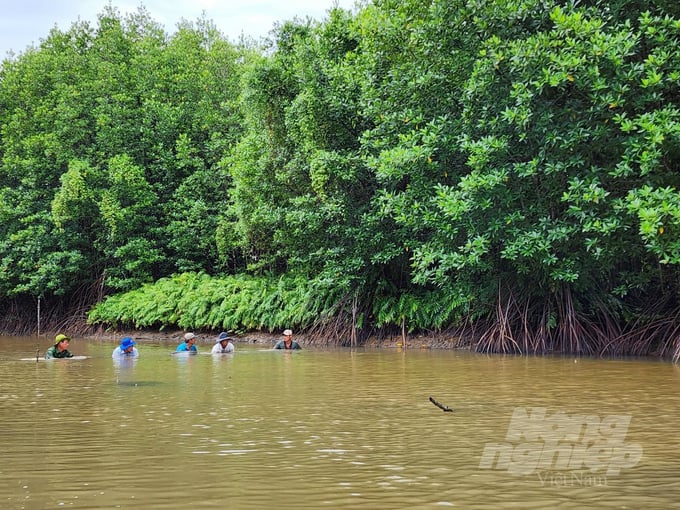
Mangroves provided livelihoods for many households in Ca Mau. Photo: Trong Linh.
Wood products have been forecast to face continuous difficulties in terms of output. As a result, many combined models were deployed under the mangrove canopy to diversify livelihoods and generate multiple sources of income. Furthermore, these models helped local people overcome difficulties, and retain forests for sustainable economic development.
The people of Ca Mau province have mainly relied on the mangrove for their livelihood. Namely, 5,143 households were assigned to forest land, and 17,457 households were contracted with forest land. Consequently, any fluctuations in forest product prices have a significant impact on people's lives.
In addition to forest trees as a main source of income, people's lives are also highly dependent on natural resources under the mangrove canopy.
The price of Melaleuca and mangrove trees is currently volatile, whereas the current price of Acacia hybrid generates a generally stable income. The average price of Melaleuca trees ranges from 50 to 60 million VND per hectare; acacia hybrid price ranges from 120 to 160 million VND per hectare; mangrove tree price ranges from 120 to 150 million VND per hectare.
Forest trees in Ca Mau primarily falls under group VI timber, so the selling price is low. In addition, there is a diverse and rich ecology of shrimp, crabs, fish, rice, fruit trees, honey, etc. under the mangrove canopy. As a result, combined production under the mangrove canopy and ecotourism development are highly recommended.
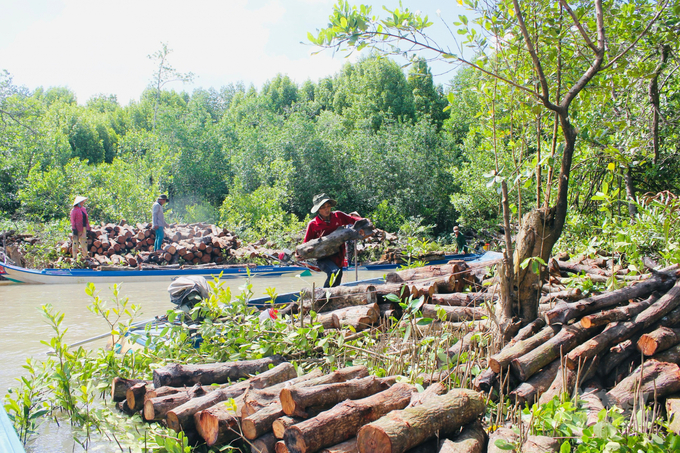
The locals of the U Minh Ha area are benefiting greatly economically from extensive timber afforestation. Photo: Trung Chanh.
Mr. Le Van Hai, Director of Ca Mau Department of Forest Protection, said that investment capital for 1 hectare of Acacia hybrid is between 40 and 50 million VND. It can generate a profit of between 160 and 200 million VND after 4 to 5 years. After 7 to 9 years, the area will develop into a big timber forest with an income between 300 and 400 million VND. The Department will continue to cooperate with its districts and communes to deploy the large timber forest model and develop large acacia wood in high-shore areas.
“Ca Mau's forestry sector has recently invited many businesses to invest in building factories in support of stable output and increased added value for wood products. Many investors have requested to loan a fairly large land area from 500 to 1,000 hectares that the province cannot meet. Despite the high number of investors, the model is only at the research stage so far", said Mr. Hai.
Although acacia hybrid is highly profitable, it must be carefully considered and converted to a balanced ratio in order to avoid oversupply, otherwise the price will drop to as low as that of the Melaleuca tree.
On the other hand, the Department will focus on exploiting the ground and water area, in combination with eco-tourism under the mangrove canopy to improve forestry economic efficiency. Most notably, the Department aims to combine joint ventures, link with various units to call for investment, as well as find sustainable output for timber.
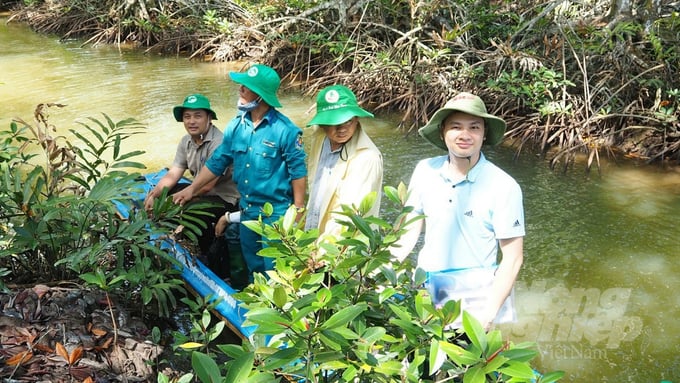
Local people can develop their economy through shrimp, crabs and fish under the canopy of mangroves. Photo: Trong Linh.
Ca Mau province has over 143,600 hectares of forest land with more than 93,000 hectares of forested area. Notably, there are 98,400 hectares of mangrove forests with more than 54,700 hectares of forested area; the area of U Minh Ha forest is estimated at 45,000 hectares with more than 38,000 hectares of forested area.
In addition to the main source of income from afforestation, people have effectively diversified their sources of income with the help of honey, banana, fish, rice as well as community eco-tourism.
Mr. Nguyen Van Loi in hamlet 15, Nguyen Phich commune, U Minh district, owns three plots of land, two of which have been dedicated to intensive Melaleuca afforestation for three years. The family's income is heavily affected by the low prices of Melaleuca wood. However, thanks to the efficient utilization of the water surface area, the embankment to raise fish, banana and fruit trees, the family does not have to rely heavily on wood products.
Mr. Loi shared that if the price remain low, he will switch to planting large timber forests. This task can be relatively difficult, but the output is higher and more stable. Income from bananas, fruit trees and other products under the mangrove canopy can also help the family develop a stable economy.
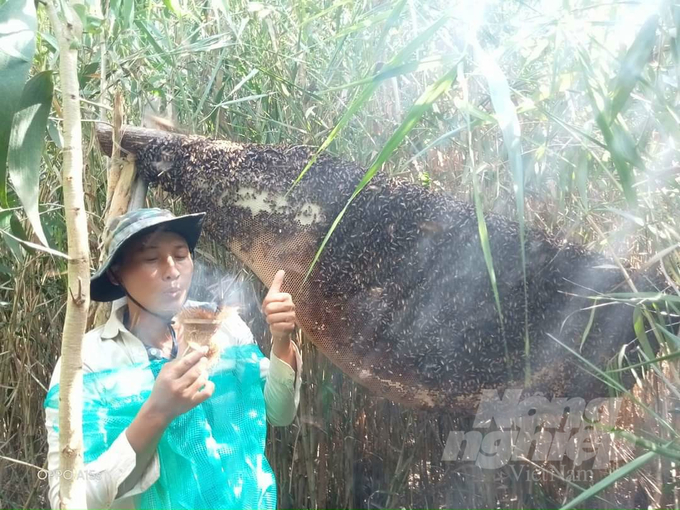
Beekeeping is a cultural aspect unique to the U Minh people. Photo: Trung Chanh.
Creating secondary livelihoods is the current development trend for forest stands across the country. Many models of wild animals raising such as mink, porcupine, pigeon, etc. in various Mekong Delta provinces' forested areas have helped many locals in the forest stand to become wealthy.
Mr. Ly Minh Kha, Deputy Director of Ca Mau Cape National Park, believes that the locals will require more supplemental forms of livelihood as they wait for the primary source of income - forests.
People in the region are currently too dependant on forest trees with low return value. According to Mr. Kha, ecotourism is the most reliable development direction at the moment.

Mr. Tran Ngoc Thao, Director of U Minh Ha Forestry One Member Company Limited in an interview with Vietnam Agriculture News. Photo: Trong Linh.
Mr. Tran Ngoc Thao, Director of U Minh Ha Forestry One Member Company Limited, remarked: Ecotourism is also the current development direction for U Minh Ha Forestry One Member Company Limited with its Song Tram Ecotourism Area currently developing strongly. The company is focusing on developing a range of tourism forms to maximize income from the forest.
According to the provincial forestry economic development orientation towards 2030, Ca Mau determined that the breakthrough solution is to focus solely on developing the forestry chain model; overcome the structural imbalance between the amplitudes of afforestation and deep processing.
The province expects an average growth rate in forest production value of 5%/year by 2025; an average added value of 4%/year. The average annual productivity of planted forests is expected to be 30 cubic meter per hectare. The province to reach 10,000 hectares of production forest with a certificate of sustainable forest management.
The forestry sector has recognized the organization of production along the value chain as a breakthrough in order to achieve said goals. A sustainable forestry chain is necessary to creating competitive advantages, improving economic efficiency for forest growers as well as forming a market for Hydrocarbon in the forestry sector.
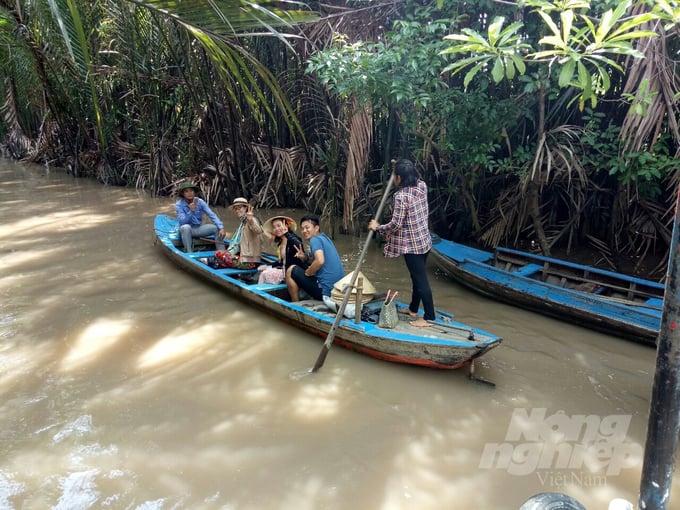
Eco-tourism is currently a popular option for many domestic and foreign tourists. Photo: Trung Chanh.
U Minh district is a region with over 45,000 hectares of forest land, accounting for approximately 56% of the natural area of the district. It has 6,700 households across 6 communes assigned to forest land, and 13 units directly managing and protecting forests. The district is focusing on many solutions to create breakthroughs in forest management, protection and development.
Mr. Le Hong Thinh, Vice Chairman of U Minh District People's Committee said that the district is focusing on raising people's awareness. On the other hand, it is deploying economic models, applying advanced technical measures in afforestation, with emphasis on large area of concentrated timber afforestation to improve productivity, quality and efficiency, as well as improve living standards for people under the mangrove canopy. Production linkage and areas of concentrated high-quality raw materials have been established to serve the development of the deep processing industry and improve the efficiency of forest land use. These activities help to achieve a sustainable forest economy, strong forest protection and management, and high quality of life for the locals. Subsequently, the district's efforts will contribute greatly to the general development of the province's economy as well as prevent natural disasters and climate change.
Translated by Nguyen Hai Long

(VAN) Cold-barn systems efficiently manage environmental and temperature conditions, which aids in the prevention of respiratory diseases in pigs and protects them from the vectors that transmit African swine fevers.
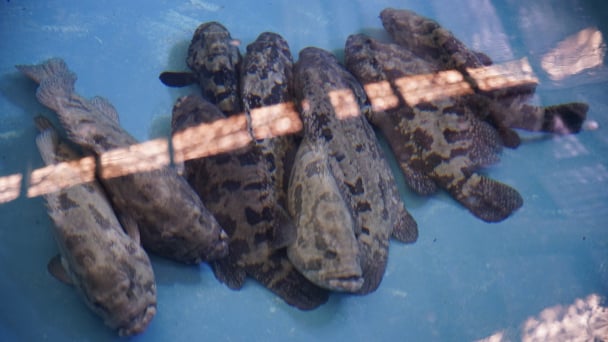
(VAN) To tackle challenges, the project 'Addressing key technical bottlenecks in the grouper supply chain in Vietnam' has been underway since 2024.

(VAN) The project 'Disease-Resilient and Sustainable Cassava Production Systems in the Mekong Region', funded by the Australian Center for International Agricultural Research (ACIAR), is being implemented from 2024 to 2028.

(VAN) Data from 10,000 farming households will help professionalize production organization and support the implementation of the One Million Hectares Program for High-Quality, Low-Emission Rice Cultivation.

(VAN) FAO Director-General QU Dongyu marks International Day of Plant Health at NENA conference.

(VAN) Deputy Minister of Agriculture and Environment Hoang Trung affirmed that floriculture and ornamental plants are a growing industry that receives significant global attention.

(VAN) The three staple crops dominating modern diets – corn, rice and wheat – are familiar to Americans. However, fourth place is held by a dark horse: cassava.